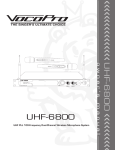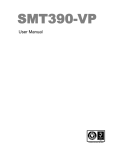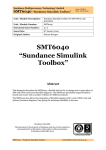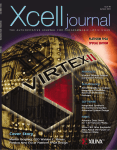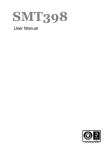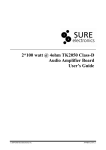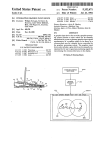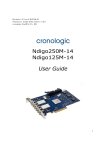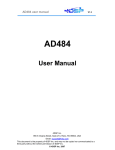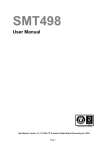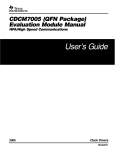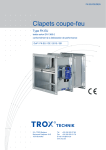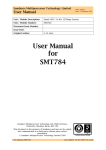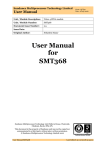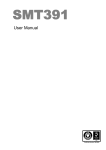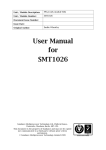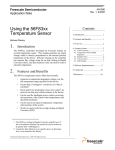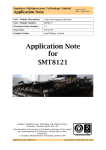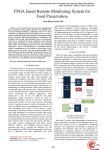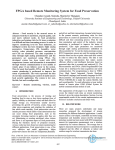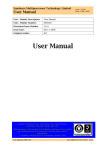Download SMT350_User_Manual - Sundance Multiprocessor Technology Ltd.
Transcript
SMT350 User Manual Version 1.9 Page 2 of 45 SMT350 User Manual Revision History Changes Made Issue Initials 11/10/05 Original Document. 1.0 PSR 18/01/06 Updates on ADC inputs and DAC outputs (impedances) 1.1 PSR 25/01/06 Added details on PHSTR synch. 1.2 PSR 31/10/06 Dac Trigger was missing. Corrected 0x0 and 0x1C register descriptions. 1.3 PSR 11/12/06 LED description added as well as J1 description. 1.4 PSR 25/01/2007 Connector list added; Control structure corrected. 1.5 PSR 05/02/2007 Figure 6 corrected. 1.6 PSR 21/02/2007 Scratch Test register description corrected. ADC PLL register (0x2) corrected. 1.7 PSR 23/03/2007 Details added to the clock circuitry. 1.8 PSR 18/12/2007 Ordering Information added 1.9 PSR Version 1.9 Page 3 of 45 SMT350 User Manual Table of Contents Physical Properties ....................................................................................................... 6 Ordering Information..................................................................................................... 6 Precautions................................................................................................................... 7 Introduction ................................................................................................................... 8 Overview ................................................................................................................... 8 Module features ........................................................................................................ 8 Possible applications ................................................................................................ 9 Related Documents .................................................................................................. 9 Functional Description ................................................................................................ 10 Block Diagram......................................................................................................... 10 Module Description ................................................................................................. 10 ADC Channels. ....................................................................................................... 12 ADC Main Characteristics. .................................................................................. 12 ADC Input Stage. ................................................................................................ 12 Dual-Channel DAC. ................................................................................................ 13 DAC Main characteristics. ................................................................................... 13 DAC output stage. ............................................................................................... 13 Clock Structure........................................................................................................ 14 Power Supply and Reset Structure......................................................................... 17 JumperJ1 ................................................................................................................ 17 Green LEDs. ........................................................................................................... 17 Mezzanine module Interface................................................................................... 17 Control Register Settings............................................................................................ 25 Control Packet Structure......................................................................................... 25 Reading and Writing Registers ............................................................................... 25 Memory Map ........................................................................................................... 26 Register Descriptions.............................................................................................. 27 Reset Register – 0x0........................................................................................... 27 Test Register – 0x1. ............................................................................................ 28 ADCA Register 0 – 0x2. ...................................................................................... 28 ADCA Register 1 – 0x3. ...................................................................................... 28 ADCA Register 2 – 0x4. ...................................................................................... 29 Version 1.9 Page 4 of 45 SMT350 User Manual ADCB Register 0 – 0x5. ...................................................................................... 29 ADCB Register 1 – 0x6. ...................................................................................... 29 ADCB Register 2 – 0x7. ...................................................................................... 30 DAC Register 0 – 0x8.......................................................................................... 30 DAC Register 1 – 0x9.......................................................................................... 30 DAC Register 2 – 0xA. ........................................................................................ 31 DAC Register 3 – 0xB. ........................................................................................ 31 DAC Register 4 – 0xC. ........................................................................................ 31 DAC Register 5 – 0xD. ........................................................................................ 31 DAC Register 6 – 0xE. ........................................................................................ 32 DAC Register 7 – 0xF. ........................................................................................ 32 CDCM7005 Register 0 – 0x10. ........................................................................... 32 CDCM7005 Register 1 – 0x11. ........................................................................... 32 CDCM7005 Register 2 – 0x12. ........................................................................... 33 CDCM7005 Register 3 – 0x13. ........................................................................... 33 CDCM7005 Register 4 – 0x14. ........................................................................... 33 CDCM7005 Register 5 – 0x15. ........................................................................... 33 CDCM7005 Register 6 – 0x16. ........................................................................... 34 CDCM7005 Register 7 – 0x17. ........................................................................... 34 Main Module Temperature (not implemented) – 0x18........................................ 34 Main Module FPGA Temperature (not implemented) – 0x19 ............................. 34 Mezzanine Module Temperature (not implemented) – 0x1A.............................. 34 Mezzanine Module Converters Temperature (not implemented) – 0x1B ........... 35 Miscellaneous Register – 0x1C........................................................................... 35 Updates, Read-back and Firmware Version Registers – 0x1D .......................... 36 DDS Register 0 – Start Phase Increment LSB - 0x20 ........................................ 37 DDS Register 1 – Start Phase Increment MSB - 0x21 ....................................... 37 DDS Register 2 – Stop Phase Increment LSB - 0x22 ........................................ 38 DDS Register 3 – Stop Increment MSB - 0x23................................................... 38 DDS Register 0 – Step Phase Increment LSB - 0x24 ........................................ 38 DDS Register 5 – Step Increment MSB - 0x25................................................... 39 FPGA Design.............................................................................................................. 40 Serial Interfaces ...................................................................................................... 40 Version 1.9 Page 5 of 45 SMT350 User Manual Block of registers .................................................................................................... 41 Space available in FPGA ........................................................................................ 41 PCB Layout................................................................................................................. 42 Connectors ................................................................................................................. 44 Description .............................................................................................................. 44 Location on the board ............................................................................................. 45 Table of Figures Figure 1 – Fan across PCI. ......................................................................................................7 Figure 2 - Block Diagram........................................................................................................10 Figure 3 - Main features. ........................................................................................................12 Figure 4 - ADC Input Stage. ...................................................................................................12 Figure 5 - DAC Output Stage. ................................................................................................14 Figure 6 - Clock Structure. .....................................................................................................14 Figure 7 - External Clock........................................................................................................16 Figure 8 - Clock Architecture Main Characteristics. ...............................................................17 Figure 9 – Mezzanine module Connector Interface (SLB data and power connectors).........18 Figure 10 – Mezzanine Module Interface Power Connector and Pinout. ...............................20 Figure 11 – Daughter Module Interface: Data Signals Connector and Pinout (Bank A). ......21 Figure 12 – Daughter Module Interface: Data Signals Connector and Pinout (Bank B). .......23 Figure 13 – Daughter Module Interface: Data Signals Connector and Pinout (Bank C). .......24 Figure 14 – Setup Packet Structure. ......................................................................................25 Figure 15 – Control Register Read Sequence. ......................................................................25 Figure 16 – Register Memory Map.........................................................................................27 Figure 17 - Firmware Block Diagram......................................................................................40 Figure 18 - Space available in FPGA .....................................................................................41 Figure 19 – Main Module Component Side............................................................................42 Figure 20 - Main Module (SMT368) Solder Side....................................................................42 Figure 21 - Daughter Module Component Side......................................................................43 Figure 22 - Daughter Module Solder Side..............................................................................43 Figure 23 - Connectors Location. ...........................................................................................45 Version 1.9 Page 6 of 45 SMT350 User Manual Physical Properties Dimensions 63.5mm x 106.7mm x 18mm Weight 35 grams Supply Voltages Supply Current +12V N/A +5V 1.2 Amps (reset / converters active) 1.4 Amps max +3.3V 0.14 Amp (reset / converters active) 0.4 Amps max -5V N/A -12V N/A MTBF Ordering Information SMT350 (Standard Product): ADC inputs and DAC outputs are AC-coupled. SMT350-DC: ADCs inputs are DC-coupled and DAC outputs are AC-coupled. Version 1.9 Page 7 of 45 SMT350 User Manual Precautions In order to guarantee that Sundance’s boards function correctly and to protect the module from damage, the following precautions should be taken: - They are static sensitive products and should be handled accordingly. Always place the modules in a static protective bag during storage and transition. - When operated in a closed environment make sure that the heat generated by the system is extracted e.g. a fan extracting heat or blowing cool air. Sundance recommends and uses PAPST 12-Volt fans (Series 8300) producing an air flow of 54 cubic meters per hour (equivalent to 31.8 CFM). Fans are placed so they blow across the PCI bus as show on the following picture: Figure 1 – Fan across PCI. Version 1.9 Page 8 of 45 SMT350 User Manual Introduction Overview The SMT350 is a single width expansion TIM that plugs onto the SLB base module SMT368 (Virtex-4 FPGA) and incorporates 2 Texas Instrument Analog-to-Digital Converters (ADS5500) and a Texas Instrument dual-channel Digital-to-Analog Converter (DAC5686). The SMT350 implements a comprehensive clock circuitry based on a CDCM7005 chip that allows synchronisation among the converters and cascading modules for multiple receiver or transmitter systems as well as the use of an external reference clock. It provides a complete conversion solution and stands as a platform that can be part of a transmit/receive base station. ADCs are 14-bit and can sample at up to 125 MHz. The DAC has a resolution of 16 bits and is able to update outputs at up to 500MHz. All converters are 3.3-Volt. The Xilinx FPGA (Virtex-4) on the base module is responsible for handling data going/coming to/from one of the following destination/source: TI converters, Comport (TIM-40 standard), Sundance High-speed Bus (SHB). These interfaces are compatible with a wide range of Sundance’s modules. The memory on base module can be divided into two 16-bit wide independent blocks for storing incoming and/or outgoing samples. Converter configuration, sampling and transferring modes are set via internal control registers stored inside the FPGA and accessible via Comport. Module features The main features of the SMT350 are listed below: ● Dual 14-bit 125MSPS ADC (ADS5500), ● Dual channel 16-bit 500MSPS DAC (DAC5686), ● On-board low-jitter clock generation (CDCM7005), ● One external clocks, two external triggers and one reference clock via MMCX connector, ● One SLB connector to link SMT350 and SMT368, ● Synchronisation signals, ● All Analogue inputs to be connected to 50-Ohm sources. ● All Analogue outputs to be connected to 50-Ohm loads. ● Temperature sensors. Version 1.9 Page 9 of 45 SMT350 User Manual Possible applications The SMT350 can be used for the following application (this non-exhaustive list should be taken as an example): ● High Intermediate-Frequency (IF) sampling architecture, ● Cellular base station such as CDMA and TDMA, ● Baseband I&Q systems, ● Wireless communication systems, ● Communication instrumentation, ● ... Related Documents ADS5500 Datasheet – Texas Instrument: http://focus.ti.com/docs/prod/folders/print/ads5500.html DAC5686 Datasheet – Texas Instrument: http://focus.ti.com/docs/prod/folders/print/dac5686.html CDCM7005 Datasheet – Texas Instrument: http://focus.ti.com/docs/prod/folders/print/cdcm7005.html Sundance High-speed Bus (SHB) specifications – Sundance. ftp://ftp2.sundance.com/Pub/documentation/pdffiles/SHB_Technical_Specification.pdf Sundance LVDS Bus (SLB) specifications – Sundance. http://www.sundance.com/docs/SLB%20-%20Technical%20Specifications.pdf TIM specifications. ftp://ftp2.sundance.com/Pub/documentation/pdf-files/tim_spec_v1.01.pdf Xilinx Virtex-4 FPGA. http://direct.xilinx.com/bvdocs/publications/ds031.pdf MMCX Connectors – Hubert Suhner. MMCX Connectors Surface Mount MMCX connector Sundance Multiprocessor Technology Ltd. SMT368 Version 1.9 Page 10 of 45 SMT350 User Manual Functional Description In this part, we will see the general block diagram and some comments on some the SMT350 entities. Block Diagram The following diagram describes the architecture of the SMT350, coupled – as an example – with an SMT368 to show how mezzanine and base modules are connected together: Power Supplies: 1.8 and 3.3 Volts Power Supplies: 1.25, 1.5, 2.5 and 3.3 Volts External ADC Trigger Temperature Sensors ADC Input Ch A MMCX 50-Ohm Channel A Signal Conditioning ADS5500 ADC ChA 14-bit 125MSPS ADC Input Ch B MMCX 50-Ohm Channel B Signal Conditioning ADS5500 ADC ChB 14-bit 125MSPS ChA Data(14), Clock and Control ChA&ChB Data, Clock and Control (60) ChB Data(14), Clock and Control ADCs and DAC External Clock In - MMCX Bank A PECL Clock Generation and Distribution based on CDCM7005 and SN65LVPC23 ADCs and DAC External Clock Out - MMCX External Reference Clock Out - MMCX DAC Clock Daughter Card interface connector DAC Output Ch B MMCX 50-Ohm Channel A Signal Conditioning Channel B Signal Conditioning DAC5686 Dual Channel DAC 16-bit 500MSPS Interpolation Spare SHB connector (SHBA) Virtex-4 XCV4SX35 Bank B SLB External Reference Clock In - MMCX DAC Output Ch A MMCX 50-Ohm SHBB ADC Channel A and Channel B FF668 Package 2xComports and Control (24) Top and Bottom TIM Connectors 448 IOs ChA Data (16) and Control Spare SHB connector (SHBC) Bank C ChB Data (16) and Control External ADC Trigger Power Daughter Card connector ChA&ChB Data, Clock and Control (60) SHBD DAC Channel A and Channel B SLB SMT350 Figure 2 - Block Diagram. Module Description The module is built around two TI ADS5500 14-bit sampling analog-to-digital converters and one TI DAC5686 dual 16-bit digital-to-analog converter. ADCs: Analog data enters the module via two MMCX connectors, one for each channel. Both signals are then conditioned (AC coupling; DC optional) before being digitized. Both ADCs gets their own sampling clock, which can be either on-board generated or from an external reference or an external clock, common to ADCs and DAC (MMCX connector). Digital samples travel to the FPGA on the base module via SMT368 Version 1.9 Page 11 of 45 SMT350 User Manual the inter-module connector (SLB – Sundance LVDS Bus, used in this case as ‘single-ended’). DAC: Digital samples are routed from the FPGA to the DAC via the inter-module connector. Internal interpolation scheme allows reaching 500 Mega Samples per Second. The DAC shows other modes such as Dual DAC, Single side-band, Quadrature or up conversion. Both outputs are AC-coupled. By default they are single-ended but can optionally be differential. The DAC mode is selected via Jumper J1, that enables or disables the DAC Internal PLL (see DAC5686 datasheet for more details). Clock generator and distribution: All samplings clocks are generated by the same chip. It allows having them all synchronized to a single reference clock. Multi-module Synchronization: There are two types of synchronization available on the SMT350. The first one is frequency synchronization, by passing the external reference clock to an other module. It first goes through a 0-delay buffer and is then output. Note that the synchronization is in frequency and not in phase. The second type is register synchronization between DACs. It is achieved by the way of an extra link between several modules to synchronize DAC internal registers (DAC signal PHSTR passed from one module to the other and driven by the master FPGA – it resets the internal VCO). Inter-module Connector: it is made of a power (33 pins) and data connectors (120 pins). It is called Sundance LVDS Bus. Please refer to the SLB specifications for more details. In the case of the SMT350, the SLB is used as ‘single-ended’. A global reset signal is mapped to the FPGA from the bottom TIM connector. External Clock signals, used to generate Sampling clocks. There is one external clock, common to ADCs and DAC When used, the CDCM7005 is used as a clock multiplexer. Also available, an external reference clock that can be passed to an other SMT350 module with ‘0-delay’. External Trigger: passed directly to base module. There are two, one for the ADCs and one for the DAC. Temperature Sensor: available for constant monitoring. Not part of default firmware provided. Version 1.9 Page 12 of 45 SMT350 User Manual ADC Channels. ADC Main Characteristics. The main characteristics of the SMT350 ADCs are gathered into the following table. Analogue Inputs Input voltage range 2.4 Vp-p (11.5 dbm – 50 Ohm) Full scale AC coupled Impedance ADC single-ended inputs are to be connected to a 50Ω source. Source impedance matching implemented between RF transformers and ADC. Bandwidth ADC bandwidth: 750 MHz. ADCs Output Output Data Width 14-Bits 2’s Compliment or offset binary Data Format (Changeable via control register) SFDR 82dBs maximum (manufacturer) SNR 70dBs maximum (manufacturer) Minimum Sampling Clock 10 MHz (ADC DLL off) Maximum Sampling Frequency 125 MHz (ADC DLL on) Figure 3 - Main features. ADC Input Stage. Each ADC Analogue input is AC-coupled via and RF transformer. The 50-Ohm resistor between the connector and the first RF transformer is not fitted because the source impedance match is implemented between the second RF transformer and the ADC by the way of two 25-Ohm resistors. Figure 4 - ADC Input Stage. Version 1.9 Page 13 of 45 SMT350 User Manual Dual-Channel DAC. DAC Main characteristics. The main characteristics of the SMT350 DAC are gathered into the following table. Analogue Outputs Input voltage range 1 Vp-p – Full scale - AC coupled Impedance DAC single-ended outputs are to be connected to a 50Ω load, which impedance matching implemented between DAC and RF transformers. Bandwidth TBD DAC Input Output Data Width per channel Data Format 16-Bits 2’s Compliment or offset binary (Changeable via control register) SFDR 89dBs maximum (manufacturer) SNR 80dBs maximum (manufacturer) Maximum input data rate 160 MSPS (Clk1 – DAC5686) Maximum Sampling rate 500 MSPS (Clk2 – DAC5686) Jumper J1 disables (position 1-2; also called External Clock Mode) or enables (position2-3; also called Internal Clock Mode) the DAC internal PLL. DAC output stage. The following piece of schematics shows how the DAC outputs are coupled. The DAC5686 generates differential output signals that are fed into an RF transformer (Ohm ratio 4), that makes both DAC channels AC coupled. 100-Ohm resistors to Vcc on the primary stage of the transformer allow balancing the secondary stage to 50 Ohm single-ended. (Note that R153 is not mounted). Version 1.9 Page 14 of 45 SMT350 User Manual Figure 5 - DAC Output Stage. Clock Structure There is one integrated clock generator on the module (CDCM7005 – Texas instrument). The user can either use this clock (on-board) or provide the module with an external clock (input via MMCX connector). Figure 6 - Clock Structure. Version 1.9 Page 15 of 45 SMT350 User Manual ADCs can both receive the same clock or the fraction of the CDCM7005 input clock (/2, /3, /4, /6, /8 or /16), the maximum being 125MHz for each ADC. This input clock can be coming from the on-board fixed VCXO or from an external source. Here is a list of possible sampling frequencies for the ADCs: ADC Sampling Frequency CDCM7005 Setting Clock source Not Allowed /1 On-board VCXO (fixed 245.76MHz) 122.88 MHz /2 On-board VCXO (fixed 245.76MHz) 81.92 MHz /3 On-board VCXO (fixed 245.76MHz) 61.44 MHz /4 On-board VCXO (fixed 245.76MHz) 40.96 MHz /6 On-board VCXO (fixed 245.76MHz) 30.72 MHz /8 On-board VCXO (fixed 245.76MHz) 15.36 MHz /16 On-board VCXO (fixed 245.76MHz) Anything between 10 and 125 MHz /1, /2, /3, /4, /6, /8 or /16 External Clock The same applies to the DAC, with a maximum sampling frequency for clk1 of 160MHz and for clk2 of 500Mhz. Below is shown how the external clock is fed to the system. By default it is singleended and AC-coupled before being converted into LVPECL format. The option of having a differential external clock is still possible on the hardware by the way of fitting or not some of the components. Version 1.9 Page 16 of 45 SMT350 User Manual Figure 7 - External Clock. The main characteristics of the SMT350 Clocks are gathered into the following table. External Reference Input Input Voltage Level 0.5 – 3.3 Volts peak-to-peak (AC-coupled) Input Impedance 50-Ohm (Termination implemented at the connector) Frequency Range 0 – 100 MHz. External Reference Output Output Voltage Level 1.6 Volts peak-to-peak (AC-coupled) Output Impedance 50-Ohm (Termination implemented at the connector) External Sampling Clock Input Input Voltage Level 0.5 – 3.3 Volts peak-to-peak (AC-coupled) Input Format Single-ended or differential on option (3.3V LVPECL). Frequency range 10-500 MHz External Sampling Clock Output Output Voltage Level 0-2.4 Volts fixed amplitude Output Format LVTTL External Trigger Inputs Input Voltage Level 1.5-3.3 Volts peak-to-peak. Format DC-coupled and Single-ended (Termination implemented at the connector). Differential Version 1.9 Page 17 of 45 SMT350 User Manual on option (3.3 V PECL). Impedance 50-Ohm. Frequency range 62.5 MHz maximum Delay External Ref. Input to Ext Ref. Out External Clk Input to Ext Clk Out 9ns (between J29 and J4) Figure 8 - Clock Architecture Main Characteristics. Power Supply and Reset Structure The SMT350 gets two power sources from the base module: 3.3 and 5 Volts. Linear regulators are used to provide a clean and stable voltage supply to the analog converters. JumperJ1 There is one jumper (3 pin header) on the board. It is to control the power supply of the DAC internal PLL. When fitted on positions 2 and 3, the PLL is enabled, whereas on positions 1 and 2, it is disabled. Please refer to the DAC5686 datasheet for more details. Green LEDs. There are 7 LEDs on the SMT350 Daughter Module. Five are dedicated for power supplies monitoring: LED1 (1.8V DAC), LED2 (3.3V Clock), LED3 (3.3V DAC), LED4 (3.3V ADCA), LED6 (3.3V ADCB) should be all ON when the board is under power. They state that power supplies all work fine. LED5 (ADCs) should be flashing once the ADC Clocks are set up. It is actually a divided version of ADCA sampling clock). LED7 (DAC) is a divided version of PLLLOCK coming from the Dac (DAC5686). Mezzanine module Interface The daughter module interface is made up of two connectors (data and power). The first one is a 0.5mm-pitch differential Samtec connector. This connector is for transferring data such as ADC or DAC samples to and from the FPGA on the main module. The second one is a 1mm-pitch Samtec header type connector. This connector is for providing power to the daughter-card. Sundance defines these two connectors as the Sundance LVDS Bus (SLB). It has originally been made for data transfers using LVDS format but can also be used with single-ended lines, which is the case for the SMT350. To know more about the SLB, please refer to the SLB specifications. Version 1.9 Page 18 of 45 SMT350 User Manual The figure underneath illustrates this configuration. The bottom view of the daughter card is shown on the right. This view must the mirrored to understand how it connects to the main module. Data connectors Bank A Bank B Bank C Power connectors Figure 9 – Mezzanine module Connector Interface (SLB data and power connectors). The female differential connector is located on the base module. The Samtec Part Number for this connector is QTH-060-01-F-D-DP-A. The female power connector is located on the base module. The Samtec Part Number for this connector is BKS-133-03-F-V-A The male differential connector is located on the mezzanine card. The Samtec Part Number for this connector is QSH-060-01-F-D-DP-A The male power connector is located on the mezzanine card. The Samtec Part Number for this connector is BKT-133-03-F-V-A The mated height between the main module and the daughter card is 5 mm. Version 1.9 Page 19 of 45 SMT350 User Manual Some JTAG Lines are also mapped onto this connector to be used in case the Daughter module would have a TI Processor. They would allow debugging and programming via JTAG. The following table shows the pin assignment on the power connector: 2 1 33 Pin Number Pin Name Description of Signal 1 D+3V3 Digital 3.3 Volts 2 DGND Digital Ground 3 D+3V3 Digital 3.3 Volts 4 DGND Digital Ground 5 D+3V3 Digital 3.3 Volts 6 DGND Digital Ground 7 D+3V3 Digital 3.3 Volts 8 DGND Digital Ground 9 D+5V0 Digital 5.0 Volts 10 DGND Digital Ground 11 D+5V0 Digital 5.0 Volts 12 DGND Digital Ground 13 D+5V0 Digital 5.0 Volts 14 DGND Digital Ground 15 D+5V0 Digital 5.0 Volts 16 DGND Digital Ground 17 D+12V0 Digital +12.0 Volts – not used on the SMT350 18 DGND Digital Ground 19 D+12V0 Digital +12.0 Volts – not used on the SMT350 20 DGND Digital Ground Version 1.9 21 Page 20 of 45 D-12V0 Digital –12.0 Volts – not used on the SMT350 22 DGND Digital Ground 23 D-12V0 Digital –12.0 Volts – not used on the SM350 24 DGND Digital Ground 25 DGND Digital Ground 26 EMU0 Emulation Control 0 – not used on SMT350 27 EMU1 Emulation Control 1 – not used on SMT350 28 TMS JTAG Mode Control – not used on SMT350 29 nTRST JTAG Reset – not used on SMT350 30 TCK JTAG Test Clock – not used on SMT350 31 TDI JTAG Test Input – not used on SMT350 32 TDO JTAG Test Output – not used on SMT350 33 DGND Digital Ground SMT350 User Manual Figure 10 – Mezzanine Module Interface Power Connector and Pinout. The following few pages describes the signals on the data connector between the main module and the daughter card. Bank A on the connector is used for the ADC Channels A and B. Bank C is used for the DAC channels A and B. Bank B is used for system clock and trigger signals, ADC/DAC/Clock control signal. Version 1.9 Page 21 of 45 Bank A SMT350 User Manual Bank B 13 57 Bank C 41 43 81 83 24 68 Bank A (ADCs) Pin No Pin Name Signal Description Pin No Pin Name Signal Description Dir Daughter Card to Main Module Dir Daughter Card to Main Module 1 DOAI0p Data Out 0, Channel A. 2 DOBI0p Data Out 1, Channel A. 3 DOAI0n Data Out 2, Channel A. 4 DOBI0n Data Out 3, Channel A. Dir Daughter Card to Main Module Dir Daughter Card to Main Module 5 DOAI1p Data Out 4, Channel A. 6 DOBI1p Data Out 5, Channel A. 7 DOAI1n Data Out 6, Channel A. 8 DOBI1n Data Out 7, Channel A. Dir Daughter Card to Main Module Dir Daughter Card to Main Module 9 DOAI2p Data Out 8, Channel A. 10 DOBI2p Data Out 9, Channel A. 11 DOAI2n Data Out 10, Channel A. 12 DOBI2n Data Out 11, Channel A. Dir Daughter Card to Main Module Dir Daughter Card to Main Module 13 DOAI3p Data Out 12, Channel A. 14 DOBI3p Data Out 13, Channel A. 15 DOAI3n Over Range, Channel A. 16 DOBI3n Data Out 0, Channel B. Dir Daughter Card to Main Module Dir Daughter Card to Main Module 17 DOAI4p Data Out 1, Channel B. 18 DOBI4p Data Out 2, Channel B. 19 DOAI4n Data Out 3, Channel B. 20 DOBI4n Data Out 4, Channel B. Dir Daughter Card to Main Module Dir Daughter Card to Main Module 21 DOAI5p Data Out 5, Channel B. 22 DOBI5p Data Out 6, Channel B. 23 DOAI5n Data Out 7, Channel B. 24 DOBI5n Data Out 8, Channel B. Dir Daughter Card to Main Module Dir Daughter Card to Main Module 25 DOAI6p Data Out 9, Channel B. 26 DOBI6p Data Out 10, Channel B. 27 DOAI6n Data Out 11, Channel B. 28 DOBI6n Data Out 12, Channel B. Dir Daughter Card to Main Module Dir Daughter Card to Main Module 29 DOAI7p Data Out 13, Channel B. 30 DOBI7p Over Range, Channel B. 31 DOAI7n Led ADC 32 DOBI7n Status Lock CDCM7005 Dir Daughter Card to Main Module Dir Daughter Card to Main Module 33 ClkOIp Data Clock Out, Channel A. 34 DOIRIp Status VCXO CDCM7005 35 ClkOIn Data Clock Out, Channel B. Status Ref CDCM7005 Dir Reserved. 37 Reserved. 39 Reserved. 36 DOIRIn Dir Reserved. Reserved. 38 Reserved ADC External Trigger, P. Reserved. 40 Reserved ADC External Trigger, N. Figure 11 – Daughter Module Interface: Data Signals Connector and Pinout (Bank A). Version 1.9 Page 22 of 45 Bank A SMT350 User Manual Bank B 13 57 Bank C 41 43 81 83 24 68 Bank B Pin No Pin Name Type Dir Signal Description Pin No Pin Name Signal Description Clock and Trigger System Signals Type Clock and Trigger System Signals Daughter Card to Main Module Dir Daughter Card to Main Module 41 SMBClk Temperature Sensor Clock. 42 SMBData Temperature Sensor Data. 43 SMBnAlert Temperature Sensor Alert. 44 SerialNo Reserved Dir Daughter Card to Main Module Dir Reserved 45 AdcVDacI Reserved 46 AdcVDacQ Reserved 47 AdcVRes Reserved 48 AdcReset Reserved Dir Main Module to Daughter Card Dir Main Module to Daughter Card 49 D3v3Enable Reserved 50 D2v5Enable Reserved 51 AdcMode ADCA Serial Clock. 52 AdcClock ADCA Serial Data. Type ADC Specific Signals Type ADC Specific Signals Dir Main Module to Daughter Card Dir Reserved 53 AdcLoad ADCA Serial Enable. 54 AdcData ADCB Serial Clock. 55 AdcCal ADCB Serial Data. 56 AdjClkCntr0 ADCB Serial Enable. Dir Main Module to Daughter Card Dir Main Module to Daughter Card 57 AdjClkCntr1 ADCs Format (binary, 2’s) 58 AdjClkCntr2 ADCs Reset 59 AdjClkCntr3 ADCs Output Enable 60 PllCntr0 CDCM7005 serial Enable. Dir Daughter Card to Main Module Dir Daughter Card to Main Module 61 PllCntr1 CDCM7005 serial Clock. 62 PllCntr2 CDCM7005 serial Data. 63 PllCntr3 CDCM7005 Clock Selection. 64 AdcAClkSel DAC PhStr. Type Module Control Signals Type Module Control Signals Dir Main Module to Daughter Card Dir Main Module to Daughter Card 65 AdcBClkSel DAC Reset. 66 IntClkDivEn DAC Pll Lock. 67 IntClkDivnReset DAC Serial Enable. 68 IntExtClkDivEn DAC Serial Clock. Dir Main Module to Daughter Card Dir Main Module to Daughter Card 69 IntExtClkDivnReset DAC Serial Data. 70 FpgaVRef Reserved 71 FpgaTck Reserved 72 FpgaTms Reserved Dir Daughter Card to Main Module Dir Reserved 73 FpgaTdi Reserved 74 FpgaTdo Reserved 75 MspVRef Reserved 76 MspTck Reserved Dir Daughter Card to Main Module Dir Reserved Version 1.9 Page 23 of 45 SMT350 User Manual 77 MspTms Reserved 78 MspTdi Reserved. 79 Msptdo Reserved 80 MspnTrst Reserved Figure 12 – Daughter Module Interface: Data Signals Connector and Pinout (Bank B). Version 1.9 Page 24 of 45 Bank A SMT350 User Manual Bank B 13 57 Bank C 41 43 81 83 24 68 Bank C (DAC) Pin No Pin Name Signal Description Pin No Pin Name Signal Description Dir Daughter Card to Main Module Dir Daughter Card to Main Module 81 DOAQ0p Data In 0, Channel A. 82 DOBQ0p Data In 1, Channel A. 83 DOAQ0n Data In 2, Channel A. 84 DOBQ0n Data In 3, Channel A. Dir Daughter Card to Main Module Dir Daughter Card to Main Module 85 DOAQ1p Data In 4, Channel A. 86 DOBQ1p Data In 5, Channel A. 87 DOAQ1n Data In 6, Channel A. 88 DOBQ1n Data In 7, Channel A. Dir Daughter Card to Main Module Dir Daughter Card to Main Module 89 DOAQ2p Data In 8, Channel A. 90 DOBQ2p Data In 9, Channel A. 91 DOAQ2n Data In 10, Channel A. 92 DOBQ2n Data In 11, Channel A. Dir Daughter Card to Main Module Dir Daughter Card to Main Module 93 DOAQ3p Data In 12, Channel A. 94 DOBQ3p Data In 13, Channel A. 95 DOAQ3n Data In 14, Channel A. 96 DOBQ3n Data In 15, Channel A. Dir Daughter Card to Main Module Dir Daughter Card to Main Module 97 DOAQ4p Data In 0, Channel B. 98 DOBQ4p Data In 1, Channel B. 99 DOAQ4n Data In 2, Channel B. 100 DOBQ4n Data In 3, Channel B. Dir Daughter Card to Main Module Dir Daughter Card to Main Module 101 DOAQ5p Data In 4, Channel B. 102 DOBQ5p Data In 5, Channel B. 103 DOAQ5n Data In 6, Channel B. 104 DOBQ5n Data In 7, Channel B. Dir Daughter Card to Main Module Dir Daughter Card to Main Module 105 DOAQ6p Data In 8, Channel B. 106 DOBQ6p Data In 9, Channel B. 107 DOAQ6n Data In 10, Channel B. 108 DOBQ6n Data In 11, Channel B. Dir Daughter Card to Main Module Dir Daughter Card to Main Module 109 DOAQ7p Data Out 12, Channel B. 110 DOBQ7p Data Out 13, Channel B. 111 DOAQ7n Data Out 14, Channel B. 112 DOBQ7n Data Out 15, Channel B. Dir Daughter Card to Main Module Dir Daughter Card to Main Module 113 Reserved. DAC Clock P. 114 Reserved. DAC LED. 115 Reserved. DAC Clock N. 116 Reserved. DAC Power Down. Dir Reserved. Dir Reserved. 117 Reserved. Reserved. 118 Reserved. DAC External Trigger, P. 119 Reserved. Reserved. 120 Reserved. DAC External Trigger, N. Figure 13 – Daughter Module Interface: Data Signals Connector and Pinout (Bank C). Version 1.9 Page 25 of 45 SMT350 User Manual Control Register Settings The Control Registers control the complete functionality of the SMT350. They are setup via the Comport3 (standard firmware provided). The settings of the ADC, triggers, clocks and the configuration of the SHB interfaces and the internal FPGA data path settings can be configured via the Control Registers. Control Packet Structure The data passed on to the SMT350 over the Comport must conform to a certain packet structure. Only valid packets will be accepted and only after acceptance of a packet will the appropriate settings be implemented. Each packet will start with a command (4 bits – 0x1 for a write operation – 0x2 for a read operation) information, followed by a register address (12 bits – see table Memory Map), followed by a 16-bit data. This structure is illustrated in the following figure: Byte Content Byte Bit 7 Bit 6 Bit 5 Bit 4 Bit 3 Bit 2 Bit 1 Bit 0 3 Command 3 Command 2 Command 1 Command 0 Address 11 Address 10 Address 9 Address 8 2 Address 7 Address 6 Address 5 Address 4 Address 3 Address 2 Address 1 Address 0 1 Data 15 Data 14 Data 13 Data 12 Data 11 Data 10 Data 9 Data 8 0 Data 7 Data 6 Data 5 Data 4 Data 3 Data 2 Data 1 Data 0 Figure 14 – Setup Packet Structure. Reading and Writing Registers Control packets are sent to the SMT350 over Comport3. This is a bi-directional interface. The format of a ‘Read Packet’ is the same as that of a write packet. Figure 15 – Control Register Read Sequence. Version 1.9 Page 26 of 45 SMT350 User Manual Memory Map The write packets must contain the address where the data must be written to and the read packets must contain the address where the required data must be read. The following figure shows the memory map for the writable and readable Control Registers on the SMT350: Address Writable Registers Readable Registers 0x00 Reset Register. Reserved. 0x01 Test Register. Test Register. 0x02 ADCA Register 0. Read-back (FPGA Register) ADCA Register 0. 0x03 ADCA Register 1. Read-back (FPGA Register) ADCA Register 1. 0x04 ADCA Register 2. Read-back (FPGA Register) ADCA Register 2. 0x05 ADCB Register 0. Read-back (FPGA Register) ADCB Register 0. 0x06 ADCB Register 1. Read-back (FPGA Register) ADCB Register 1. 0x07 ADCB Register 2. Read-back (FPGA Register) ADCB Register 2. 0x08 DAC Register 0. Read-back (FPGA Register) DAC Register 0. 0x09 DAC Register 1. Read-back (FPGA Register) DAC Register 1. 0x0A DAC Register 2. Read-back (FPGA Register) DAC Register 2. 0x0B DAC Register 3. Read-back (FPGA Register) DAC Register 3. 0x0C DAC Register 4. Read-back (FPGA Register) DAC Register 4. 0x0D DAC Register 5. Read-back (FPGA Register) DAC Register 5. 0x0E DAC Register 6. Read-back (FPGA Register) DAC Register 6. 0x0F DAC Register 7. Read-back (FPGA Register) DAC Register 7. 0x10 CDCM7005 Register 0. Read-back (FPGA Register) CDCM7005 Register 0. 0x11 CDCM7005 Register 1. Read-back (FPGA Register) CDCM7005 Register 1. 0x12 CDCM7005 Register 2. Read-back (FPGA Register) CDCM7005 Register 2. 0x13 CDCM7005 Register 3. Read-back (FPGA Register) CDCM7005 Register 3. 0x14 CDCM7005 Register 4. Read-back (FPGA Register) CDCM7005 Register 4. 0x15 CDCM7005 Register 5. Read-back (FPGA Register) CDCM7005 Register 5. 0x16 CDCM7005 Register 6. Read-back (FPGA Register) CDCM7005 Register 6. 0x17 CDCM7005 Register 7. Read-back (FPGA Register) CDCM7005 Register 7. 0x18 Reserved Main Module Temperature 0x19 Reserved Main Module FPGA Temperature 0x1A Reserved Mezzanine Module Temperature 0x1B Reserved Mezzanine Module Converter Temperature 0x1C Misc Register (Trigger, Clock Selection, etc…). Read-back Misc Register. 0x1D Update and Read-back command Register Firmware Version and Status bits. 0x20 DDS Register 0 – Start Phase Increment LSB Read-back (FPGA Register) DDS Register 0. 0x21 DDS Register 1 – Start Phase Increment MSB Read-back (FPGA Register) DDS Register 1. 0x22 DDS Register 2 – Stop Phase Increment LSB Read-back (FPGA Register) DDS Register 2. 0x23 DDS Register 3 – Stop Phase Increment MSB Read-back (FPGA Register) DDS Register 3. Version 1.9 Page 27 of 45 SMT350 User Manual 0x24 DDS Register 4 – Step Phase Increment LSB Read-back (FPGA Register) DDS Register 4. 0x25 DDS Register 5 – Step Phase Increment MSB Read-back (FPGA Register) DDS Register 5. Figure 16 – Register Memory Map. Register Descriptions Reset Register – 0x0. Reset Register – 0x0 Byte Bit 7 Bit 6 Bit 5 0 Reserved Reserved DDS Reset Default ‘0’ ‘0’ ‘1’ Bit 4 Bit 3 Bit 2 Bit 1 Bit 0 PHSTR CDCM7005 Reset DAC Reset ADCs Reset ‘00’ ‘1’ ‘1’ ‘1’ Reset Register – 0x0 Setting Bit 0 Description 0 0 Normal Operation. 1 1 Resets both ADC devices as well as their corresponding Serial Interfaces. Setting Bit 1 0 0 Normal Operation. 1 1 Resets both DAC device as well as its Serial Interfaces. Setting Bit 2 0 0 Normal Operation. 1 1 Resets both CLK device as well as its Serial Interfaces. Setting Bit 4&3 0 00 Normal Operation – DAC PHSTR is Tri-Stated. 1 01 DAC PHSTR line is driven High. 2 10 DAC PHSTR line is driven Low. 3 11 Normal Operation – DAC PHSTR is Tri-Stated. Setting Bit 5 0 0 DDS Activated and SHB put on hold. 1 1 Resets DDS Core (SHB samples are routed to the DAC) Description Description Description Description Note 1: What is mentioned as DAC PHSTR line is the physical net on the board that connects together the FPGA to the PHSTR pin (DAC5686) as well as to J5 (+). In a multiple board system, one board can be used as a master and its PHSTR pin can be driven high or low and an other one as slave, in which case its DAC PHSTR pin must be tri-stated. Note 2: The Reset bits don’t get cleared automatically, so a device can remain reset while not used to reduce the global power consumption. Version 1.9 Page 28 of 45 SMT350 User Manual Test Register – 0x1. Any 8-bit value written in this register can be read-back to check that the Comport used works properly. Test Register – 0x1 Byte Bit 7 Bit 6 Bit 5 Bit 4 Bit 3 Bit 2 Bit 1 Bit 0 Bit 2 Bit 1 Bit 0 0 ADCA Register 0 – 0x2. For more details, refer to ADS5500 datasheet. ADCA Register 0 – 0x2 Byte Bit 7 Bit 6 Bit 5 Bit 4 Bit 3 1 Reserved Default ‘0000000’ 0 Reserved PLL Reserved Default ‘000000’ ‘0’ ‘0’ Bit 2 Bit 1 Bit 0 TP1 TP0 Reserved ‘0’ ‘0’ ‘0’ ADCA Register 0 – 0x2 Setting Bit 1 Description 0 0 PLL OFF – for sampling frequencies between 10 and 80 MHz 1 1 PLL ON – for sampling frequencies between 60 and 125 MHz ADCA Register 1 – 0x3. For more details, refer to ADS5500 datasheet. ADCA Register 1 – 0x3 Byte Bit 7 Bit 6 Bit 5 Bit 4 1 Reserved Default ‘00000’ Bit 3 0 Reserved Default ‘00000000’ ADCA Register 1 – 0x3 Setting TP1 TP0 Description 0 0 0 Normal Mode of Operation 1 0 1 All outputs are zeroes 2 1 0 All outputs are ones 3 1 1 Continuous stream of ‘10’ Version 1.9 Page 29 of 45 SMT350 User Manual ADCA Register 2 – 0x4. For more details, refer to ADS5500 datasheet. ADCA Register 2 – 0x4 Byte Bit 7 Bit 6 Bit 5 1 Reserved Default ‘000’ Bit 4 Bit 3 Bit 2 Bit 1 PDN Reserved ‘0’ ‘000’ 0 Reserved Default ‘00000000’ Bit 0 ADCA Register 2 – 0X4 Setting PDN Description 0 0 Normal Mode of Operation 1 1 Device in Power Down Mode ADCB Register 0 – 0x5. For more details, refer to ADS5500 datasheet. ADCB Register 0 – 0x5 Byte Bit 7 Bit 6 Bit 5 Bit 4 Bit 3 1 Reserved Default ‘0000000’ Bit 2 Bit 1 Bit 0 0 Reserved PLL Reserved Default ‘000000’ ‘0’ ‘0’ ADCB Register 0 – 0x5 Setting Bit 1 0 0 PLL OFF – for sampling frequencies between 10 and 80 MHz Description 1 1 PLL ON – for sampling frequencies between 60 and 125 MHz ADCB Register 1 – 0x6. For more details, refer to ADS5500 datasheet. ADCB Register 1 – 0x6 Byte Bit 2 Bit 1 Bit 0 1 Bit 7 Bit 6 Reserved Bit 5 Bit 4 Bit 3 TP1 TP0 Reserved Default ‘00000’ ‘0’ ‘0’ ‘0’ 0 Reserved Default ‘00000000’ ADCB Register 1 – 0x6 Setting TP1 0 0 TP0 0 Description Normal Mode of Operation Version 1.9 Page 30 of 45 1 0 1 2 1 0 All outputs are ones 3 1 1 Continuous stream of ‘10’ SMT350 User Manual All outputs are zeroes ADCB Register 2 – 0x7. For more details, refer to ADS5500 datasheet. ADCB Register 2 – 0x7 Byte Bit 7 Bit 6 Bit 5 Bit 4 Bit 3 Bit 2 Bit 1 1 Reserved PDN Reserved Default ‘000’ ‘0’ ‘000’ 0 Reserved Default ‘00000000’ Bit 0 ADCB Register 2 – 0x7 Setting PDN 0 0 Normal Mode of Operation Description 1 1 Device in Power Down Mode DAC Register 0 – 0x8. For more details, refer to DAC5686 datasheet. DAC Register 0 – 0x8 Byte Bit 7 Bit 6 Bit 5 0 atest Default ‘000000’ Bit 4 Bit 3 Bit 2 Bit 1 Bit 0 Version ‘000’ 1 Freq_int[7:0] Default ‘00000000’ DAC Register 1 – 0x9. For more details, refer to DAC5686 datasheet. DAC Register 1 – 0x9 Byte Bit 7 Bit 6 Bit 5 Bit 4 Bit 3 0 Freq_int[15:8] Default ‘00000000’ 1 Freq_int[23:16] Default ‘00000000’ Bit 2 Bit 1 Bit 0 Version 1.9 Page 31 of 45 SMT350 User Manual DAC Register 2 – 0xA. For more details, refer to DAC5686 datasheet. DAC Register 2 – 0xA Byte Bit 7 Bit 6 Bit 5 Bit 4 Bit 3 Bit 2 Bit 1 Bit 0 Bit 2 Bit 1 Bit 0 Freq_int[31:24] 0 Default ‘00000000’ 1 Phase_int[7:0] Default ‘00000000’ DAC Register 3 – 0xB. For more details, refer to DAC5686 datasheet. DAC Register 3 – 0xB Byte Bit 7 Bit 6 Bit 5 Bit 4 Bit 3 Phase _int[15:8] 0 ‘00000000’ Default 1 Mode[1:0] Div[1:0] Sel[1:0] Counter Full bypass Default ‘00’ ‘00’ ‘00’ ‘0’ ‘0’ DAC Register 4 – 0xC. For more details, refer to DAC5686 datasheet. DAC Register 4 – 0xC Byte Bit 7 Bit 6 Bit 5 Bit 4 Bit 3 Bit 2 Bit 1 Bit 0 0 Ssb Interl Sinc Dith Sync Phstr Nco Sif4 Twos Default ‘0’ ‘0’ ‘0’ ‘0’ ‘0’ ‘0’ ‘0’ ‘0’ 1 Dual_clk DSS_gain[1:0] Rspect Qflag Pll_rng[1:0] Rev_bus Default ‘0’ ‘00’ ‘0’ ‘0’ ‘00’ ‘0’ DAC Register 5 – 0xD. For more details, refer to DAC5686 datasheet. DAC Register 5 – 0xD Byte Bit 7 Bit 6 Bit 5 Bit 4 Bit 3 0 Daca_offset[7:0] Default ‘00000000’ 1 Daca_gain[7:0] Default ‘00000000’ Bit 2 Bit 1 Bit 0 Version 1.9 Page 32 of 45 SMT350 User Manual DAC Register 6 – 0xE. For more details, refer to DAC5686 datasheet. DAC Register 6 – 0xE Byte Bit 7 Bit 6 Bit 5 Bit 4 Daca_offset[10:8] 0 Bit 3 Bit 2 Bit 1 sleepa Daca_gain[11:8] ‘0’ ‘0000’ Default 1 Dacb_offset[7:0] Default ‘00000000’ Bit 0 DAC Register 7 – 0xF. For more details, refer to DAC5686 datasheet. DAC Register 7 – 0xF Byte Bit 7 Bit 6 Bit 5 Bit 4 Bit 3 Bit 2 Bit 1 Bit 0 Dacb_gain[7:0] 0 ‘00000000’ Default 1 Dacb_offset[10:8] sleepb Dacb_gain[11:8] Default ‘000’ ‘0’ ‘0000’ CDCM7005 Register 0 – 0x10. For more details, refer to CDCM7005 datasheet. CDCM7005 Register 0 – 0x10 Byte Bit 7 Bit 6 Bit 5 Bit 4 Bit 3 Bit 2 Bit 1 1 VCXO_divider[3:0] Reference Divider[9:6] Default ‘0000’ ‘0000’ Bit 0 0 Reference Divider[5:0] Register Selection[1:0] Default ‘000000’ ‘00’ CDCM7005 Register 1 – 0x11. For more details, refer to CDCM7005 datasheet. CDCM7005 Register 1 – 0x11 Byte Bit 7 Bit 6 Bit 5 Bit 4 1 Freq Detect Manual or Auto Ref. Programmable Delay N[2:0] Programmable Delay M[2:0] Default ‘0’ ‘0’ ‘000’ ‘000’ 0 VCXO_divider[11:4] Default ‘00000000’ Bit 3 Bit 2 Bit 1 Bit 0 Version 1.9 Page 33 of 45 SMT350 User Manual CDCM7005 Register 2 – 0x12. For more details, refer to CDCM7005 datasheet. CDCM7005 Register 2 – 0x12 Byte Bit 7 Bit 6 Bit 5 Bit 4 Bit 3 Bit 2 Bit 1 Bit 0 1 OUT2A0 OUT1B1 OUT1B0 OUT1A1 OUT1A0 OUT0B1 OUT0B0 OUT0A1 Default ‘0’ ‘0’ ‘0’ ‘0’ ‘0’ ‘0’ ‘0’ ‘0’ 0 OUT0A0 Output Signaling Selcetion[5:0] Register Selection[1:0] Default ‘0’ ‘00000’ ‘01’ CDCM7005 Register 3 – 0x13. For more details, refer to CDCM7005 datasheet. CDCM7005 Register 3– 0x13 Byte Bit 7 Bit 6 Bit 5 Bit 4 Bit 3 Bit 2 Bit 1 Bit 0 1 90Div8 90Div4 ADClock Status VCXO Status Ref OUT4B1 OUT4B0 OUT4A1 Default ‘0’ ‘0’ ‘0’ ‘0’ ‘0’ ‘0’ ‘0’ ‘0’ 0 OUT4A0 OUT3B1 OUT3B0 OUT3A1 OUT3A0 OUT2B1 OUT2B0 OUT2A1 Default ‘0’ ‘0’ ‘0’ ‘0’ ‘0’ ‘0’ ‘0’ ‘0’ CDCM7005 Register 4 – 0x14. For more details, refer to CDCM7005 datasheet. CDCM7005 Register 4 – 0x14 Byte Bit 7 Bit 6 Bit 5 Bit 4 Bit 3 Bit 2 Bit 1 Bit 0 1 Y0_MUX Width FB_MUX PDF Pulse Default ‘000’ ‘000’ ‘00’ 0 CP Current PRECP CP_DIR Register Selection[1:0] Default ‘0000’ ‘0’ ‘0’ ‘10’ CDCM7005 Register 5 – 0x15. For more details, refer to CDCM7005 datasheet. CDCM7005 Register 5– 0x15 Byte Bit 7 Bit 6 Bit 5 Bit 4 Bit 3 Bit 2 1 Hold Reset ResHold Power Down Y4_MUX Default ‘0’ ‘0’ ‘0’ ‘0’ ‘000’ Bit 1 Bit 0 Y3_MUX ‘0’ 0 Y3_MUX Y2_MUX Y1_MUX Default ‘00’ ‘000’ ‘000’ Version 1.9 Page 34 of 45 SMT350 User Manual CDCM7005 Register 6 – 0x16. For more details, refer to CDCM7005 datasheet. CDCM7005 Register 6 – 0x16 Byte Bit 7 Bit 6 Bit 5 Bit 4 Reserved 1 ‘0000’ Default Bit 3 Bit 2 Bit 1 Bit 0 Hold Reserved Hold Function1 Reserved ‘0’ ‘0’ ‘0’ ‘0’ 0 Reserved Cycle Slip Lock Cycles Lock Window Register Selection[1:0] Default ‘0’ ‘0’ ‘00’ ‘00’ ‘11’ CDCM7005 Register 7 – 0x17. For more details, refer to CDCM7005 datasheet. CDCM7005 Register 7 – 0x17 Byte Bit 7 Bit 6 Bit 5 Bit 4 1 Reserved Default ‘00000000’ 0 Reserved Default ‘00000000’ Bit 3 Bit 2 Bit 1 Bit 0 Bit 2 Bit 1 Bit 0 Bit 2 Bit 1 Bit 0 Bit 2 Bit 1 Bit 0 Main Module Temperature (not implemented) – 0x18 Main Module Temperature – 0x18 Byte Bit 7 Bit 6 Bit 5 Bit 4 Bit 3 0 Temperature in Celcius Degrees Default ‘00000000’ Main Module FPGA Temperature (not implemented) – 0x19 Main Module FPGA Temperature – 0x19 Byte Bit 7 Bit 6 Bit 5 Bit 4 Bit 3 0 Temperature in Celcius Degrees Default ‘00000000’ Mezzanine Module Temperature (not implemented) – 0x1A Mezzanine Module Temperature – 0x1A Byte Bit 7 Bit 6 Bit 5 Bit 4 Bit 3 0 Temperature in Celcius Degrees Default ‘00000000’ Version 1.9 Page 35 of 45 SMT350 User Manual Mezzanine Module Converters Temperature (not implemented) – 0x1B Mezzanine Module Converters Temperature – 0x1B Byte Bit 7 Bit 6 Bit 5 Bit 4 Bit 3 0 Temperature in Celcius Degrees Default ‘00000000’ Bit 2 Bit 1 Bit 0 Miscellaneous Register – 0x1C. Miscellaneous Register – 0x1C Byte Bit 5 Bit 4 Bit 3 Bit 2 Bit 1 Bit 0 0 Bit 7 Reserved Bit 6 ADC Trigger - Selection ADC Trigger - Polarity ADC Trigger - Internal ADCs Data Clock Selection Reference Selection Default ‘00’ ‘0’ ‘0’ ‘0’ ‘0’ ‘0’ ‘0’ 1 Reserved DAC Trigger - Selection DAC Trigger - Polarity DAC Trigger - Internal Reserved SHB Selection Default ‘00’ ‘0’ ‘0’ ‘0’ ‘0’ ‘00’ Miscellaneous Register – 0x1C Setting Bit 13 Description 0 0 Internal DAC Trigger (from register 0x1C – bit 11) selected. 1 1 External DAC Trigger (from connector J24) selected. Miscellaneous Register – 0x1C Setting Bit 12 Description 0 0 Polarity DAC Trigger signal selected – Non-Inverting. 1 1 Polarity DAC Trigger signal selected – Inverting. Miscellaneous Register – 0x1C Setting Bit 11 0 0 Internal DAC Trigger set to ‘0’. Description 1 1 Internal DAC Trigger set to ‘1’. Setting Bit 9/8 0 00 ADC Channel A and B ; 1 sample of each ADC channel packed onto one 32-bit word. [ChB ChA] 1 01 ADC Channel A only ; 2 samples packed onto one 32-bit word [word(t+1) word(t)] 2 10 ADC Channel B only ; 2 samples packed onto one 32-bit word [word(t+1) word(t)] 3 11 ADC Channel A and B ; 1 sample of each ADC channel packed onto one 32-bit word. [ChB ChA] Miscellaneous Register – 0x1C Description Miscellaneous Register – 0x1C Setting Bit 5 0 0 Internal ADC Trigger (from register 0x1C – bit 3) selected. Description 1 1 External ADC Trigger (from connector J24) selected. Setting Bit 4 0 0 Polarity ADC Trigger signal selected – Non-Inverting. 1 1 Polarity ADC Trigger signal selected – Inverting. Miscellaneous Register – 0x1C Description Miscellaneous Register – 0x1C Version 1.9 Page 36 of 45 Setting Bit 3 0 0 Internal ADC Trigger set to ‘0’. 1 1 Internal ADC Trigger set to ‘1’. SMT350 User Manual Description Miscellaneous Register – 0x1C Setting Bit 2 0 0 Binary Format. Description 1 1 2’s Complement. Setting Bit 1 0 0 VCXO selection. 1 1 External Source Selected. Miscellaneous Register – 0x1C Description Miscellaneous Register – 0x1C Setting Bit 0 Description 0 0 On-Board 10-MHz Reference Clock selected. 1 1 External Reference Selected. Updates, Read-back and Firmware Version Registers – 0x1D The Update bit activates the corresponding Serial Interface to pass registers previously written in the FPGA, into the corresponding device (ADCA, ADCB, DAC or CLK devices). The Read-back bit activates the corresponding Serial Interface to read-back register values from the corresponding device and to pass them to the FPGA. This operation must be followed by Read-back register operations. Note that only the DAC allows proper read-back operation. Other devices read-back commands would only perform a read-back of the FPGA register. Update and Read-back commands – 0x1D Byte Bit 7 Bit 6 Bit 5 Bit 4 Bit 3 Bit 2 Bit 1 Bit 0 0 Reserved DDS Step Update DDS Stop Update DDS Start Update CLK Update DAC Update ADCB Update ADCA Update Default ‘0’ ‘0’ ‘0’ ‘0’ ‘0’ ‘0’ ‘0’ ‘0’ ‘0’ ‘0’ DAC Read-back 1 Default ‘0’ ‘0’ ‘0’ ‘0’ ‘0’ ‘0’ Reading-back this register returns the Firmware version as well as some Status signals coming from the CDCM7005. Version 1.9 Page 37 of 45 SMT350 User Manual Firmware Version – 0x1D Byte Bit 7 Bit 6 Bit 5 Bit 4 Bit 3 0 Firmware Version Default ‘00000000’ 1 Default ‘0’ ‘0’ ‘0’ ‘0’ Bit 2 Bit 1 Bit 0 CDCM7005 Status VCXO CDCM7005 Status Ref CDCM7005 Status Lock ‘0’ ‘0’ ‘0’ ‘0’ DDS Register 0 – Start Phase Increment LSB - 0x20 DDS Register 0 – 0x20 Byte Bit 7 Bit 6 Bit 5 Bit 4 Bit 3 Bit 2 Bit 1 Bit 0 Bit 2 Bit 1 Bit 0 DDS Start Phase Increment[15…8] 1 Default ‘00000000’ 0 DDS Start Phase Increment [7…0] Default ‘00000000’ DDS Register 1 – Start Phase Increment MSB - 0x21 DDS Register 1 – 0x21 Byte Bit 7 Bit 6 Bit 5 Bit 4 Bit 3 1 DDS Start Phase Increment [31…24] Default ‘00000000’ 0 DDS Start Phase Increment [23…16] Default ‘00000000’ The Start Phase Increment value is coded on 32 bits (DDS Data registers 0x20 and 0x21). Each value corresponds to a frequency generated worked out as follows: Fout = Start Phase Increment * FDAC sampling (MHz) / 232 When the DDS is used in sweep mode, Start Phase Increment should be lower than Stop Phase Increment and Step Phase Increment should be greater than 0. When used to generate a fixed frequency, Start Phase Increment should be equal to Stop Phase Increment and Step Phase Increment should be equal to 1. For Registers 0x20 and 0x21 to take effect, Bit 4 of register 0x1D must be set to 1. DAC Channel A is the Sine output of the DDS and DAC Channel B is the Cosine output of the DDS. Both outputs are therefore is quadrature. The Maximum Phase increment value supported by the design is 0x40000000, which corresponds to a frequency of 30.72MHz when sampling at 122.88MHz with no interpolation. Version 1.9 Page 38 of 45 SMT350 User Manual DDS Register 2 – Stop Phase Increment LSB - 0x22 DDS Register 2 – 0x22 Byte Bit 7 Bit 6 Bit 5 Bit 4 Bit 3 1 DDS Stop Phase Increment [15…8] Default ‘00000000’ 0 DDS Stop Phase Increment [7…0] Default ‘00000000’ Bit 2 Bit 1 Bit 0 Bit 2 Bit 1 Bit 0 DDS Register 3 – Stop Increment MSB - 0x23 DDS Register 3 – 0x23 Byte Bit 7 Bit 6 Bit 5 Bit 4 Bit 3 DDS Stop Phase Increment [31…24] 1 Default ‘00000000’ 0 DDS Stop Phase Increment [23…16] Default ‘00000000’ The Stop Phase Increment value is coded on 32 bits (DDS Data registers 0x22 and 0x23). Each value corresponds to a frequency generated worked out as follows : Fout = Stop Phase Increment * FDAC sampling (MHz) / 232 When the DDS is used in sweep mode, Start Phase Increment should be lower than Stop Phase Increment and Step Phase Increment should be greater than 0. When used to generate a fixed frequency, Start Phase Increment should be equal to Stop Phase Increment and Step Phase Increment should be equal to 1. For Registers 0x22 and 0x23 to take effect, Bit 5 of register 0x1D must be set to 1. DAC Channel A is the Sine output of the DDS and DAC Channel B is the Cosine output of the DDS. Both outputs are therefore is quadrature. The Maximum Phase increment value supported by the design is 0x40000000, which corresponds to a frequency of 30.72MHz when sampling at 122.88MHz with no interpolation. DDS Register 0 – Step Phase Increment LSB - 0x24 DDS Register 4 – 0x24 Byte Bit 7 Bit 6 Bit 5 Bit 4 Bit 3 1 DDS Step Phase Increment [15…8] Default ‘00000000’ 0 DDS Step Phase Increment [7…0] Default ‘00000000’ Bit 2 Bit 1 Bit 0 Version 1.9 Page 39 of 45 SMT350 User Manual DDS Register 5 – Step Increment MSB - 0x25 DDS Register 5 – 0x25 Byte Bit 7 Bit 6 Bit 5 Bit 4 Bit 3 1 DDS Step Phase Increment [31…24] Default ‘00000000’ 0 DDS Step Phase Increment [23…16] Default ‘00000000’ Bit 2 Bit 1 Bit 0 The Step Phase Increment value is coded on 32 bits. It corresponds to the increment in phase on each sampling clock cycle (Sweep Mode). When used to generate a fixed frequency, Start Phase Increment should be equal to Stop Phase Increment and Step Phase Increment should be equal to 1. For Registers 0x24 and 0x25 to take effect, Bit 6 of register 0x1D must be set to 1. DAC Channel A is the Sine output of the DDS and DAC Channel B is the Cosine output of the DDS. Both outputs are therefore is quadrature. Version 1.9 Page 40 of 45 SMT350 User Manual FPGA Design The following block diagram shows how the default FPGA design is structured: Figure 17 - Firmware Block Diagram. Serial Interfaces All serial interfaces have been designed in accordance with manufacturers datasheets and validated by probing and checking against timing provided. Version 1.9 Page 41 of 45 SMT350 User Manual Block of registers This implements what has previously been described in this document. Space available in FPGA This is the summary provided by Xilinx ISE 7.1.04i regarding the amount of resources required by the default FPGA design – this is targeting a Virtex4 XC4VSX35. Figure 18 - Space available in FPGA Version 1.9 Page 42 of 45 SMT350 User Manual PCB Layout The following figures show the top and bottom view of the main module, the top view of the daughter-card and the module composition viewed from the side. Figure 19 – Main Module Component Side. Figure 20 - Main Module (SMT368) Solder Side. Version 1.9 Page 43 of 45 Figure 21 - Daughter Module Component Side. Figure 22 - Daughter Module Solder Side. SMT350 User Manual Version 1.9 Page 44 of 45 SMT350 User Manual Connectors Description The following table gathers all connectors on the board and describes their function. Connector (silkscreen schematics) name Description and Location on the board J13 ADCA Analog Input Middle / Left J11 ADCB Analog Input Middle / Left J32 DACA Analog Output Middle / Right J31 DACB Analog Output Middle / Right J30 External Reference Input Top / Left J29 External Clock Input Top / Left J34 External Reference Output Top / Right J4 External Clock Output Top / Right J24 External Trigger ADCs Bottom / Left J25 External Trigger DAC Bottom / Left Version 1.9 Page 45 of 45 Location on the board Figure 23 - Connectors Location. SMT350 User Manual













































